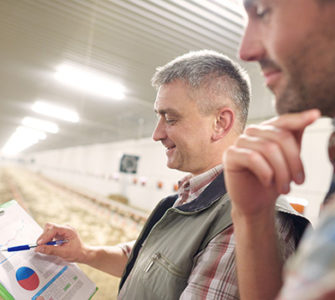Reductions in medically important antimicrobials reflect industry stewardship
Reductions in the use of medically important antimicrobials demonstrate the poultry industry’s commitment to stewardship of these valuable medications, Randall Singer, DVM, MPVM, PhD, told Poultry Health Today.
Singer’s comments were based on data reflecting antimicrobial use in poultry from 2013 through 2017. The project is supported by FDA and the US Poultry and Egg Association and has been conducted by Mindwalk Consulting Group, LLC, founded by Singer.
Just one example he cited of antimicrobial stewardship is the reduction in the percentage of broilers placed that received an antimicrobial at the hatchery, which dropped from 93% in 2013 to just 17% in 2017, according to an executive summary of the data.
“The companies are finding a way to prevent [disease] without that hatchery antimicrobial,” he said, and emphasized that disease prevention should be the goal versus a focus on simply reducing antimicrobial use. Sometimes, Singer pointed out, an antimicrobial administered at the hatchery is needed if there are certain diseases, like Escherchia coli, affecting birds, especially around brooding.
‘Steady decline’
Poultry companies have been reducing antibiotic use since well before January 2017, when FDA’s guidance documents took effect, tightening the reins on the use of medically important antibiotics. “For the most part it was a pretty steady decline between 2013 and 2017,” he continued, ranging from a 40% to 70% reduction in the use of medically important antimicrobials, depending on the class of drug and route of administration.
Some antimicrobials have no remaining approved uses — tylosin for broilers is one example — and their use went to zero. In other cases, the use of some antimicrobials peaked in 2015, perhaps because there were disease challenges, Singer said.
Veterinarians doing their job
Antimicrobials should be used when needed, but focusing simply on reductions in antimicrobial use can lead to conflicts with animal health and welfare, he indicated.
“There are going to be years where disease incidence is going to spike. Certain diseases in certain companies might increase,” he said. “Well, you’re going to have to use an antimicrobial for therapy in those situations…that doesn’t mean that we’re now failing in stewardship. It means, I hope, that the veterinarians are doing their job to take care of the birds they oversee. And so, again, if we focus too much on reductions, on targeted reductions, I think we miss the point, which is around stewardship and good disease prevention.”
Singer expressed similar sentiments about no antibiotic production. “…my hope is that the veterinarians that oversee those birds are going to give those birds therapy when needed — that we’re not letting marketing decide,” Singer said, and added that he hopes the decision around using an antimicrobial remains in the hands of veterinarians as it should be.
Although the data demonstrates substantial drops in the use of medically important antibiotics in broilers, there was a shift toward more use of antibiotics that are not medically important, such as bacitracin. For turkeys, the shift from medically important to nonmedically important antibiotics has been more difficult because there aren’t as many nonmedically important antimicrobial options, Singer said.
Quantifying results
Since the movement toward reduced use of antimicrobials in food animals is largely driven by an effort to reduce antibiotic resistance in people, Poultry Health Today asked the professor how the results can be quantified. “It’s very difficult to quantify. Absolutely,” he replied.
“I think the thing to remember is that antimicrobial use in any setting — animals, crops, human health — is going to have some effect on the bugs — the bacteria that carry resistance mechanisms in some capacity. We may never find a very clear cause-and-effect relationship, but we do know that in total, our antimicrobial use does affect resistance,” he said.
Inappropriate measures
Singer expressed frustration with reports that sum the amount of antimicrobials used in food animals across all antimicrobial classes. “To me, that’s a very inappropriate measure to be using…because different antimicrobials have different potencies, meaning they have different molecular weights.
“It’s about how many birds you are treating and are you picking the right drug, for the right bug, at the right time?”
On poultry farms, most antimicrobials used will be administered orally in water or feed, and an orally administered drug is always going to have more milligrams per bird as a dose compared to using an injectable drug. “…if you’re comparing amount of drug used and you don’t take into account the route of administration, you don’t even have a fair comparison.”
Post-2017 data
The data from 2013 to 2017 represent at least 90% of annual broiler production and 80% of annual turkey production, which Singer described as an “incredible” response, especially considering that participation in the data-gathering project has been voluntary. He and colleagues are continuing to collect data for broilers and turkeys but will now also gather data on antimicrobial use in layers.
Post-2017 data should have better detail since that’s when more veterinary oversight kicked in. It should reflect which flock received which antimicrobial, for what disease, at what age as well as details about how the drug was administered and for how long, he said.
Singer said FDA, which uses a science-based approach when it comes to labeling antimicrobials, is re-evaluating its list of medically and nonmedically important antimicrobials. He expects those revisions in the next couple years. “And you know, we’ll adjust our practices accordingly.”
The full report about antimicrobial use in poultry is available here.
Posted on October 2, 2019

















